A Survey of 300+ Decision Makers
From mobile banking to artificial intelligence, the products and services that businesses and consumers have at their disposal are better than ever before. The pace of innovation, and the accompanying increase in consumer expectations, is only escalating. In this environment, conducting exhaustive research studies and planning sessions in an attempt to find the “perfect” course of action is no longer viable. The need for speed and iteration precludes outdated strategies. It’s now more important than ever for companies to adapt the way they work and make decisions.
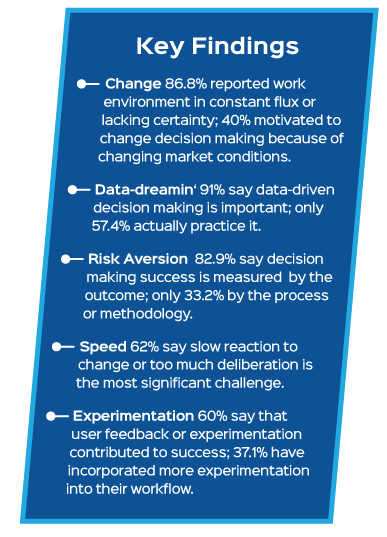
In March of 2019, Alpha, the first on-demand insights platform, surveyed over 300 decision-makers to discover their most significant challenges and most effective decision making processes. We discovered that the forces of change, both from the internal company organization and external market forces, have changed the nature of business decision making. 86.8% of respondents report that their work environment is in constant flux or lacking clear correct decisions, and 40% say that they’re motivated to change their decision-making process because of changing market conditions.
Many companies have made progress to adopt data-driven decision-making frameworks and launch new products and features faster. However, decision-makers now face an overabundance of data inputs while remaining obligated to numerous stakeholders. The difference between a good decision and a bad decision is less clear than ever before.
Faced with this increasingly challenging decision-making environment, it’s incumbent on companies to adapt if they want to gain and maintain market leadership. But adapting is not only important to Wall Street. 79.4% of respondents say that their ability to make good decisions is important or extremely important for their career advancement.
While much of the ink spilt on this topic since the beginning of the digital age has focused on buzz words such as “big data” and “agile”, our findings paint a more nuanced picture.
A central lesson that emerged from this report is that while having data is certainly necessary for good decision making, it’s by no means sufficient. There’s a striking gap between respondents wanting to use data to make decisions and actually using it. 91% say that it’s important or very important to make data-driven decisions, but only 57.4% often or almost always do so.
The gap could be partially attributed to the fact that while decision-makers are motivated to make data-driven decisions and run experiments, their organizations don’t actually support them doing so. Decision-makers are challenged by entrenched thinking, a lack of shared understanding of modern methodologies, and slow reactions to change.
In the digital age, good decision making entails taking more shots on goal and shortening iteration cycles. However, few decision-makers are rewarded for such an approach. 82.9% of respondents say that their companies measure the success of a decision by the outcome that is achieved while only 33.2% assess based on the process or methodology used to make the decision.
In addition, even though many leaders espouse the benefits of empowering those closest to the problem to make decisions, senior executives take control all too frequently. 46.8% of respondents say that decisions are primarily made from the top down. This helps explain why 62% say that the most significant challenge that their teams face when trying to make good decisions is too much deliberation or slow reaction to change.
While this report reveals the challenges and frustrations that decision-makers face today, it’s not a chronicle of doom and gloom. There is a reason for optimism. Over 60% of respondents say that user feedback or experimentation have contributed to their most successful projects, and 37.1% say that they’ve incorporated more experimentation into their decision-making process within the past twelve months.
Our findings indicate that decision-makers have less of a need for a larger amount of data. Rather, they need the right data, faster along with the appropriate team structure and company culture to perform at their best. With the right resources, methodologies, and tools, decision-makers can help their companies avoid the fate of companies how haven’t adapted to change, such as Toys R Us and Polaroid, and become the next Airbnb or Amazon.
About Our Respondents
310 decision-makers completed our survey. Respondents work in a variety of industries. The vast majority manage digital products.

About two-thirds of respondents work in product roles. The remaining third is split amongst marketing, strategy, and innovation roles. Respondents make decisions about product, strategy, design, and human resources.
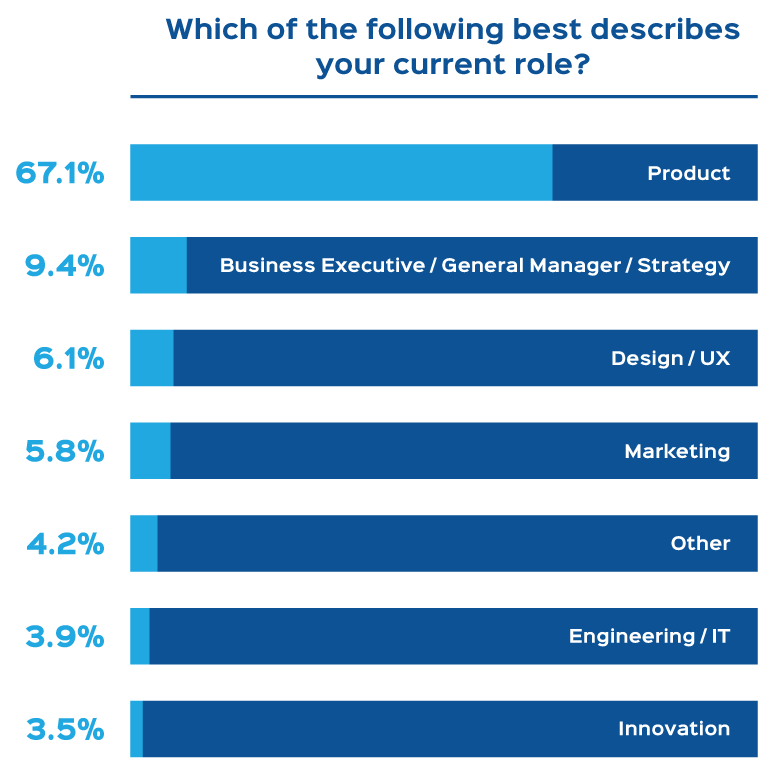
Our respondents make a wide range of business decisions on a weekly basis. Most commonly: product, strategy, and design.
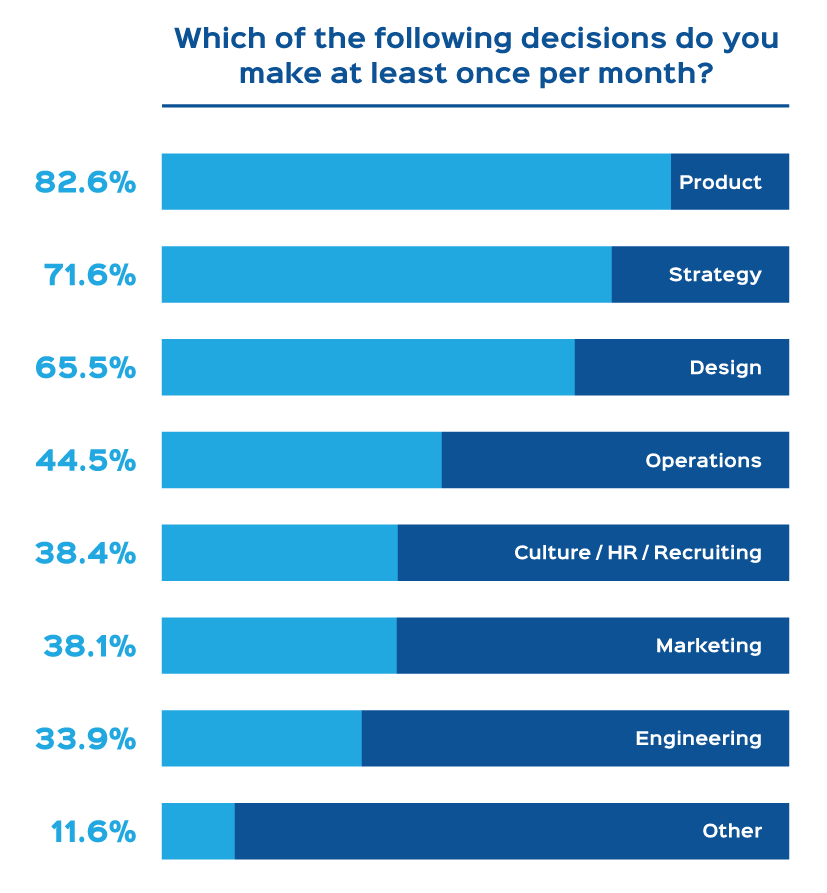
Methodologies, Techniques and Tools
Decision-makers regularly rely on user feedback, cost-benefit analysis, and analytics to determine the best course of action. However, those techniques don’t quite match what they said contributed to their most successful projects. Respondents more often say that experimentation, or small-scale tests, contributed to their most successful projects.
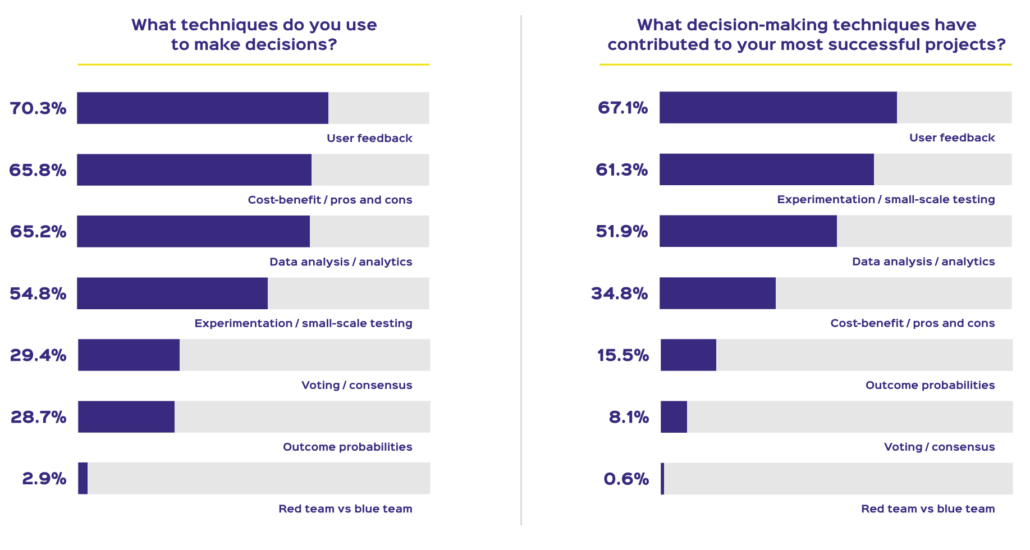
The tools that respondents use most frequently include analytics tools, such as Google Analytics, and user insights tools, such as Alpha. The frequency at which they onboard new tools hasn’t changed significantly over the past twelve months.

Good consultants and agencies can be an important driver of growth and innovation because of their ability to think, speak, and act independently. However, most respondents don’t regularly retain consultants to support decision making and those that don’t retain consultants who specialize in decision making. Rather, the consultants have functional or industry expertise. Our findings suggest that there’s a lack of dedicated resources for decision making.
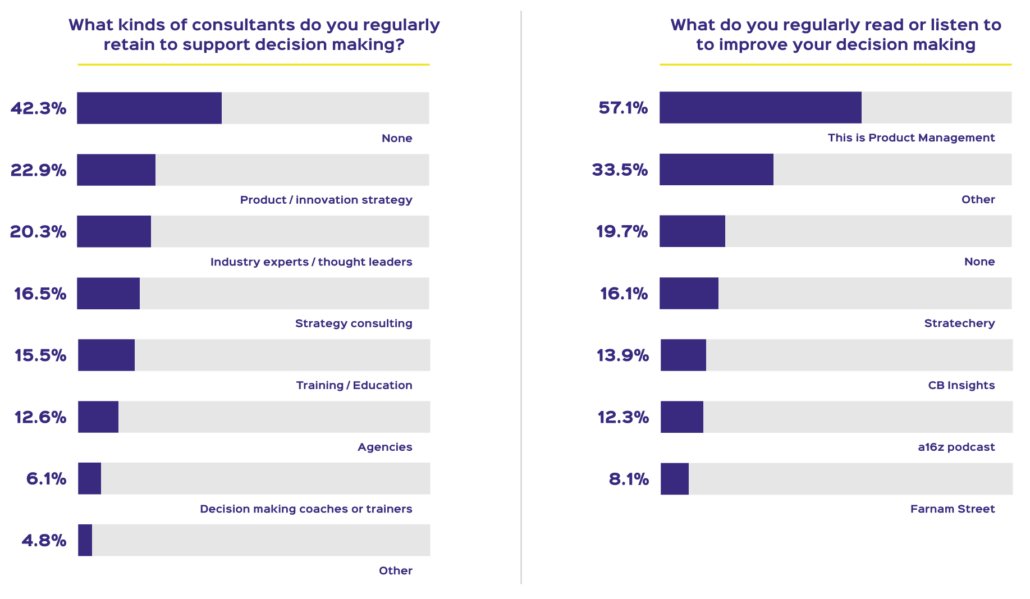
In large organizations, there are many stakeholders whose opinions and needs need to be taken into consideration, and several different goals and priorities that need to be met. The most common criteria for determining if a decision or course of action is the best one is alignment with the company vision and strategy. This seems like a positive data point. However, the probability of success, also ranked highly, which indicates an aversion to risk and experimentation.
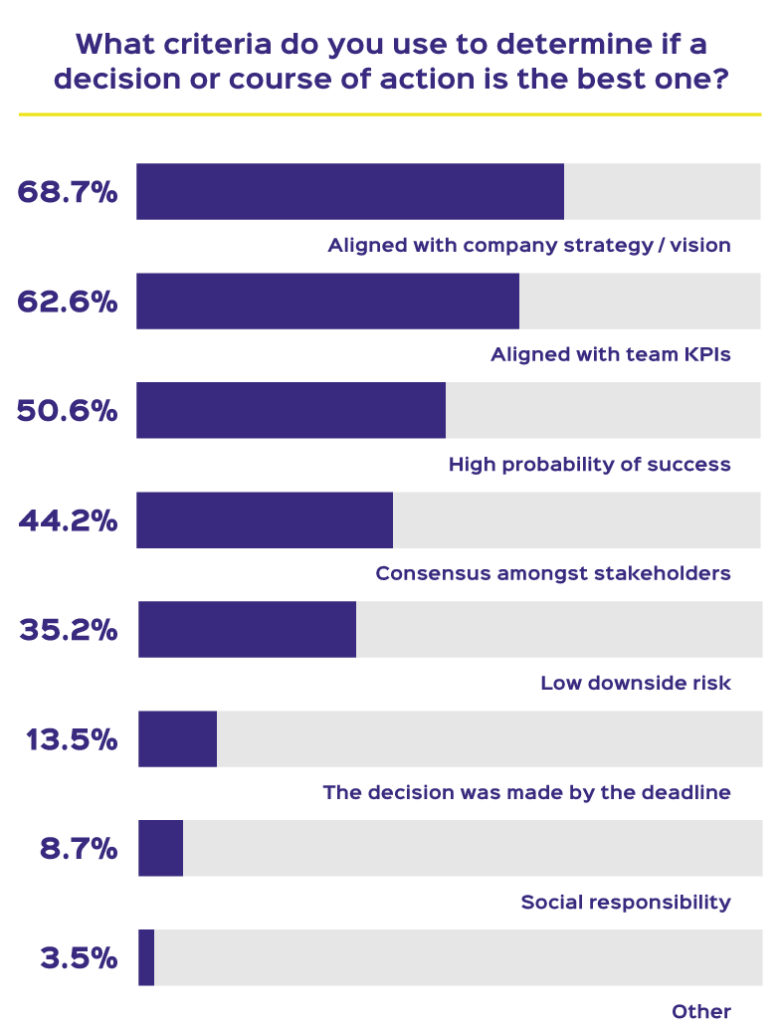
3. Data-Driven decision making
Respondents predominantly agree about the importance of using data to make decisions. However, they fail to capitalize on this practice. Only 21.9% always or almost always use data to make important decisions, while 42.6% analyze data haphazardly.

There are now more sources of data than ever before. Respondents most frequently utilize user research, analytics, and experimentation to gather data.
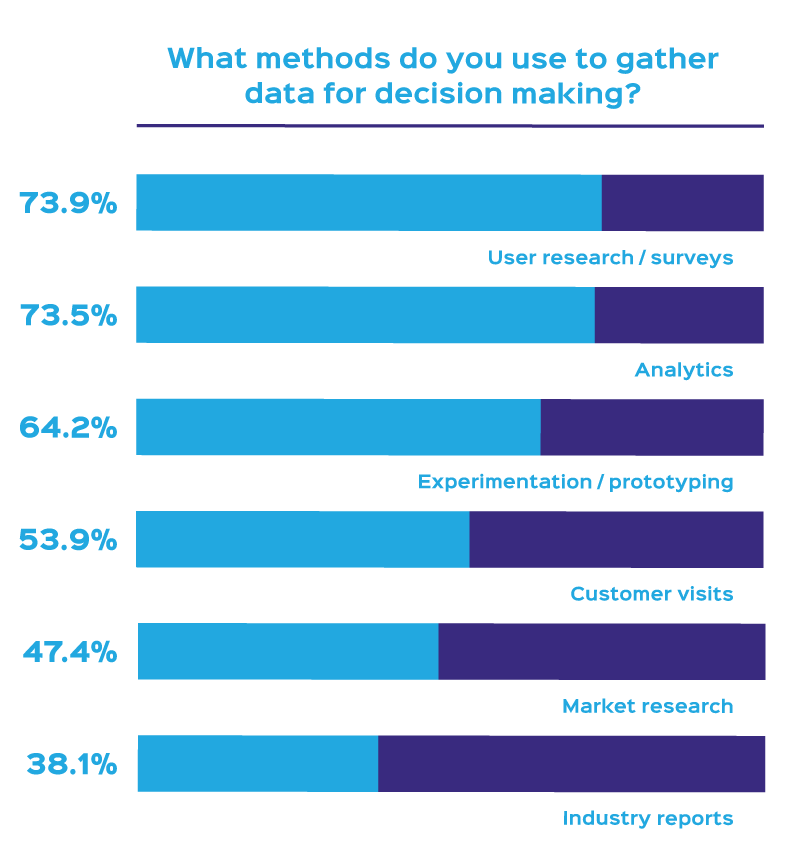
47.1% report having a sufficient amount of data. This ties with our finding that less than one-third of respondents say they lack data.
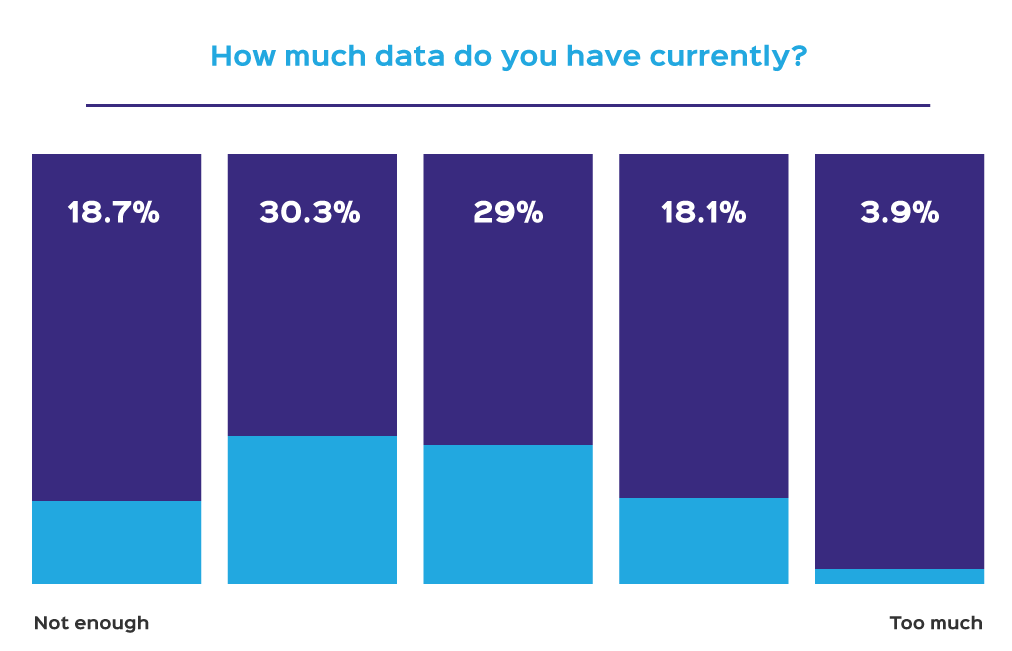
There’s a clear gap between wanting to use data and actually using data. Respondents say that a shared understanding of the methodology amongst stakeholders, and a faster or easier way to get data would best support their ability to close the gap.

One user shared a story about how a lack of shared understanding about data-driven decision making contributed to an unsuccessful project:
Leadership wanted a certain feature in a product and assumed all users would want it. [A] round of user research [made] it clear that they didn’t want it. [The]product team was forced to put it in, citing the typical iPod Steve Jobs example. [The] product was updated, and users hated the feature and complained. Leadership had a hard lesson in realizing they’re not Steve Jobs.
4. Collaboration
While over a third of respondents say their companies decide with a mix of top-down and bottom-up processes, companies are more likely than not to be top-down (46.8%). 49.2% of respondents report that senior executives or vice presidents make major decisions. This suggests a preponderance of top-down management and decision making.
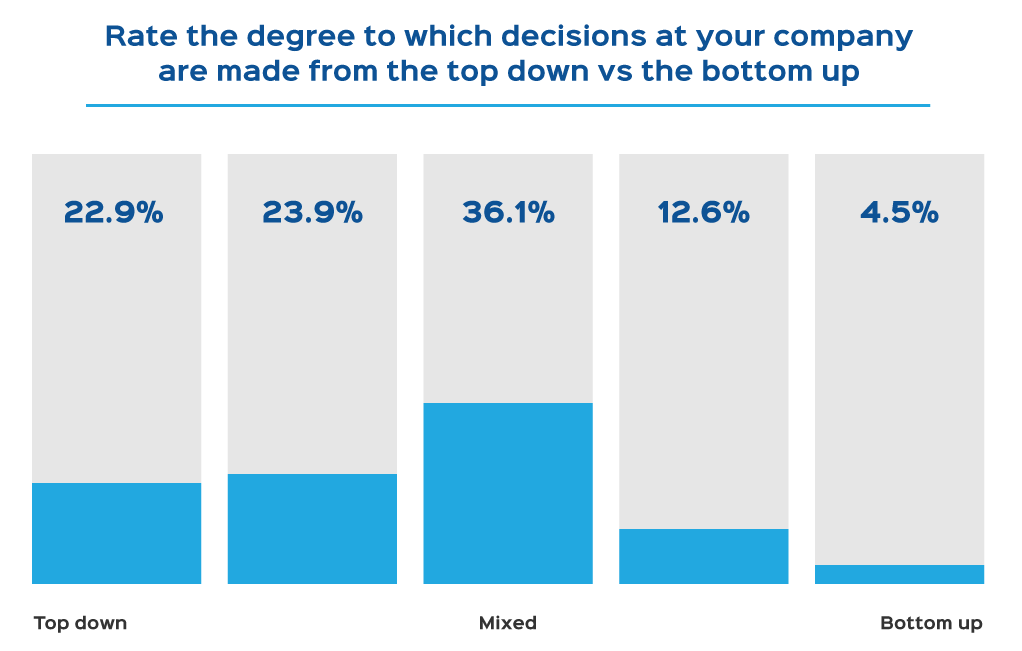
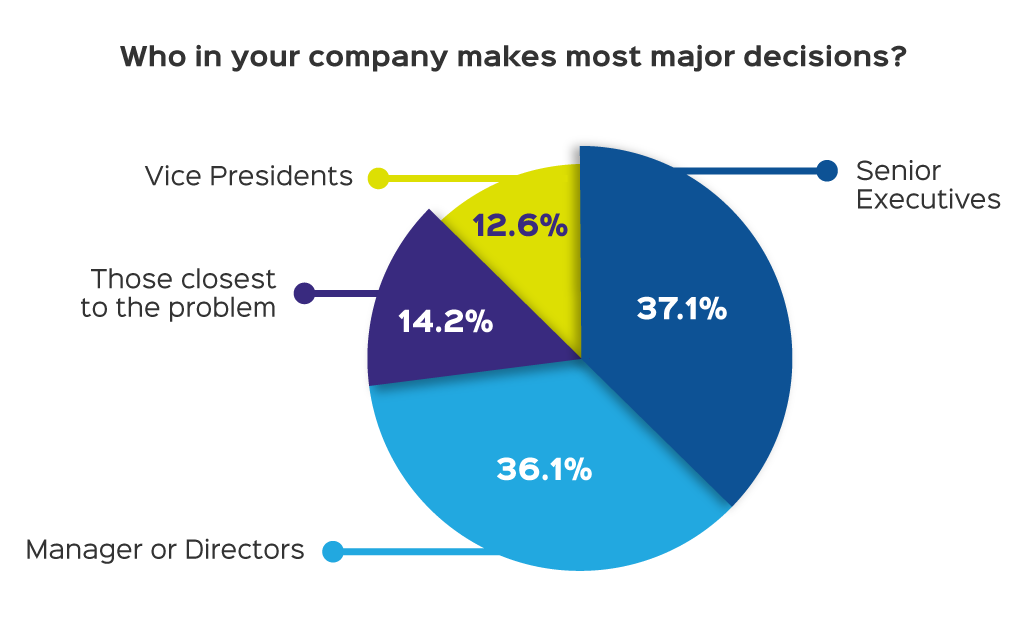
Respondents primarily have a balanced approach to collaborating with senior leadership, wherein respondents make recommendations and senior leadership has the final say.
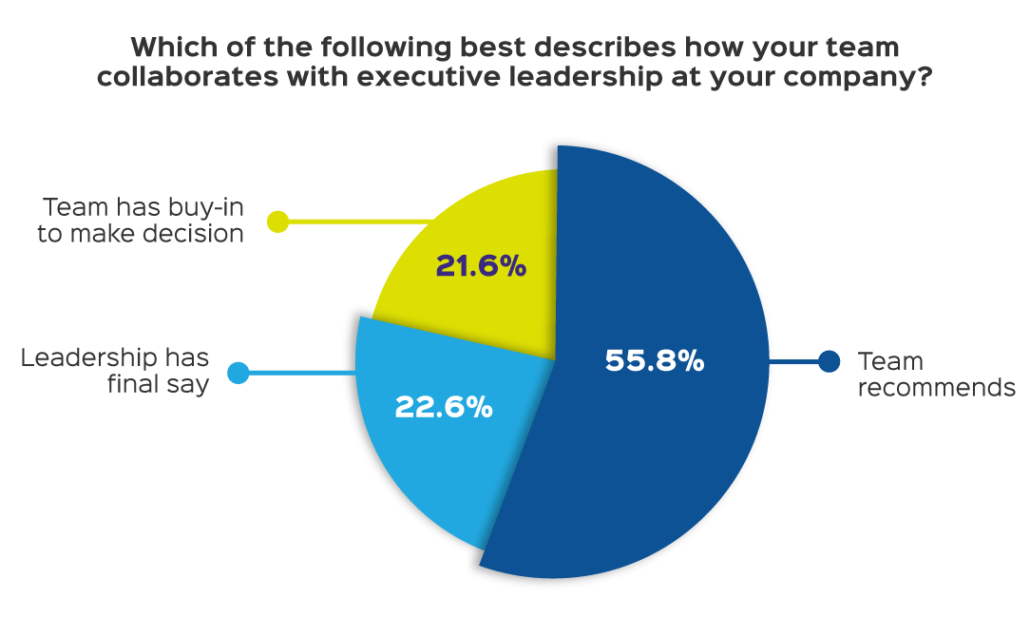
Collaboration between junior and senior stakeholders can help bridge the gap between business needs and customer needs, as one respondent shared:
Our top stakeholders actually sit in and listen to our customer base to understand their needs. Once understood, there were better decisions made overall that combined their business intentions with what our users wanted.
However, collaboration can go awry when there isn’t a mutual understanding of how to make data-driven decisions. One respondent explained how this caused people to leave the company:
We presented options (with data) and management selected a third option (because they knew). Negative effects were seen and persist. The team was disillusioned and most [team members] left.
Decision-makers most often collaborate with teams in most major functions. However, they say that market research teams best support their ability to make good decisions.
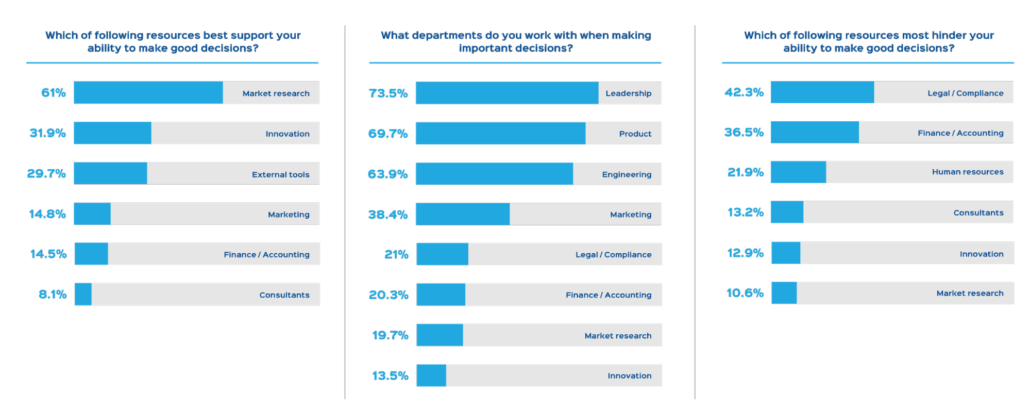
22.3% of respondents typically make decisions in teams of 6 to 10 people. However, only 8.4% of respondents say that teams of that size are best for decision making. People say teams of 2 to 5 people make for the best decision-making process. These findings lend proof to the ‘two pizza teams‘ theory popularized by Amazon’s Jeff Bezos: no matter how large your company gets, individual teams shouldn’t be larger than what two pizzas can feed.
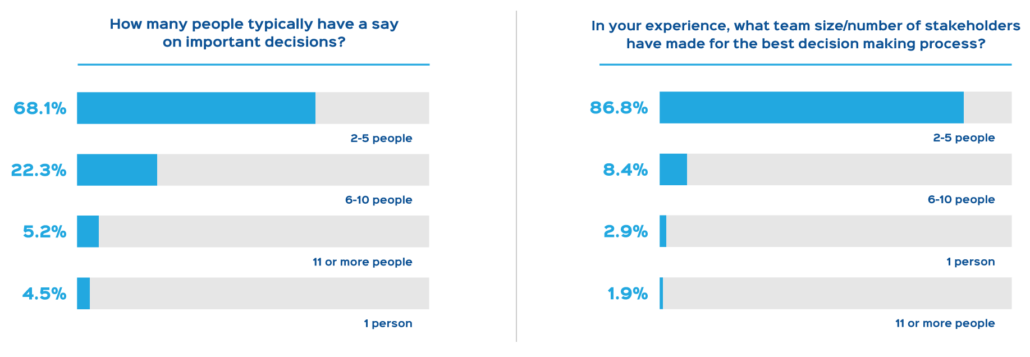
5. Evaluating Decisions
Making good decisions helps the company’s bottom line as well as your own. 79.4% say it is important or extremely important for their career advancement and their accountability for those decisions is increasing.

We reported above that one of the most important criteria for making a decision is that it has a high probability of success. 82.9% of decision-makers say that the outcome of the decision – the degree to which it achieved its intended goals – is the most important measure of a decision. For comparison, just 33.2% say that the process for making the decision is most important.
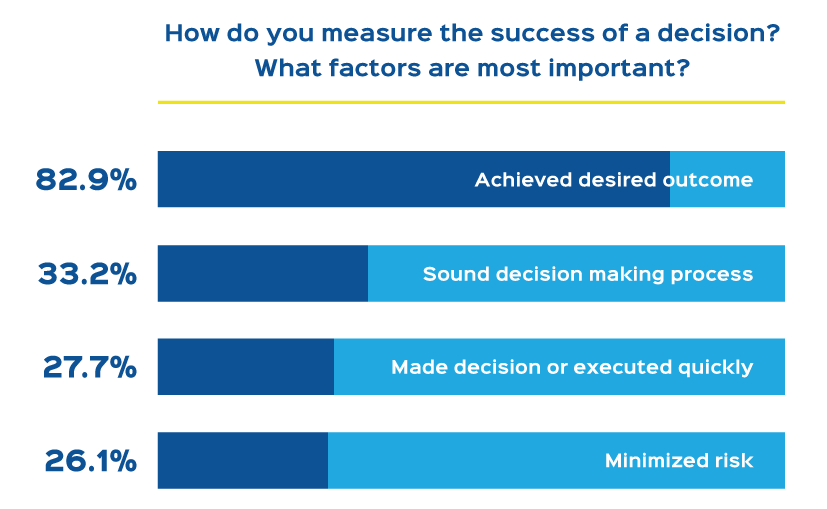
If the result of months-long research is inconclusive, it can be hard for executives to justify further funding for those topics. Though best practices for innovation are to run – even though they don’t always work – decision-makers aren’t rewarded for good decisions that lead to bad outcomes.
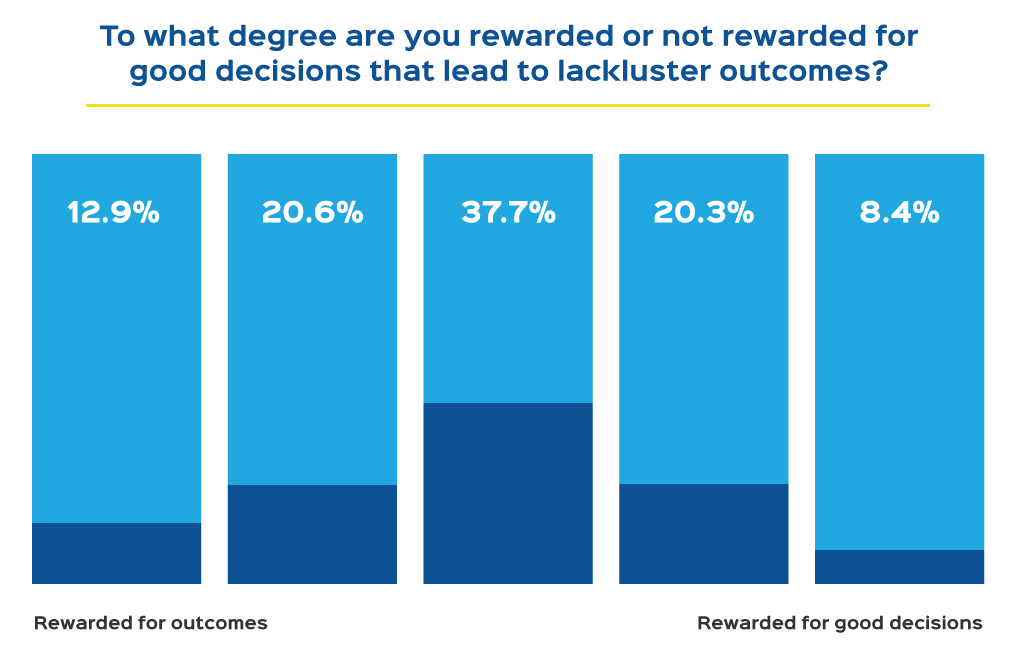
Only 8.4% of respondents debrief one year or more after making a decision. Over one third don’t debrief at all. Important projects often take years to materialize. If companies don’t measure results over the long term, it might be hard to justify projects that take longer to show results.
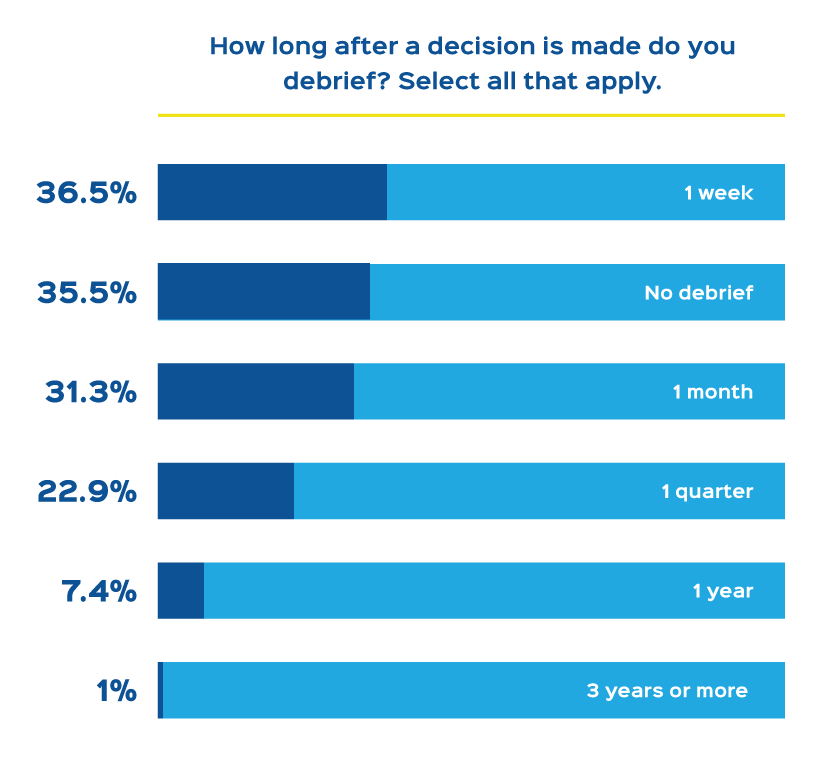
6. Challenges
Respondents find that decisions about company identity, strategy, and culture are the most difficult to make. Product and feature decisions are a close second.
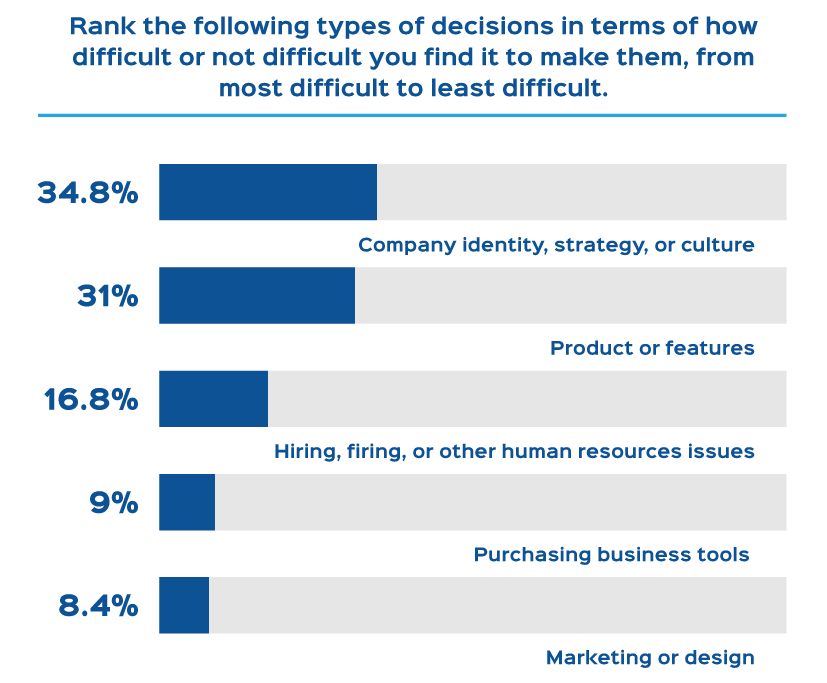
Decision-makers say that they are challenged by a cocktail of insufficient information, too much deliberation, entrenched thinking, and a lack of autonomy.
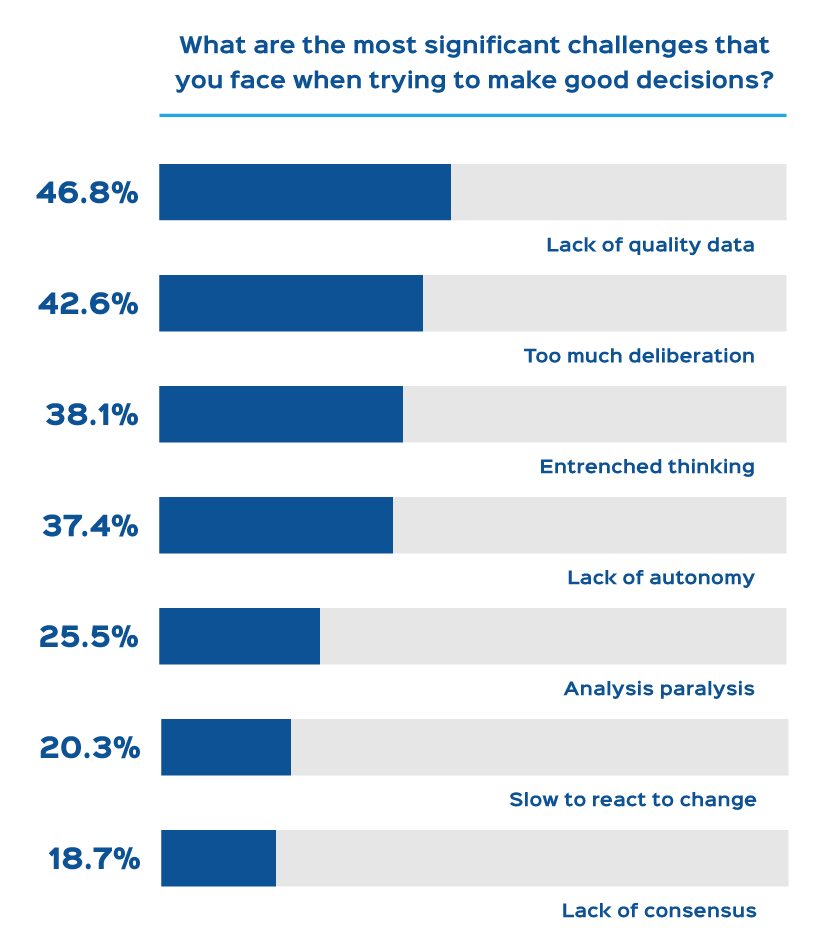
One-third of respondents say that lack of quality data is a hurdle for making data-driven decisions. Most people are sitting on the data they need. Many frustrations arise from a lack of shared understanding of what the data is and how it should be understood. In other words, they have data but not the ability to craft a convincing narrative from it.
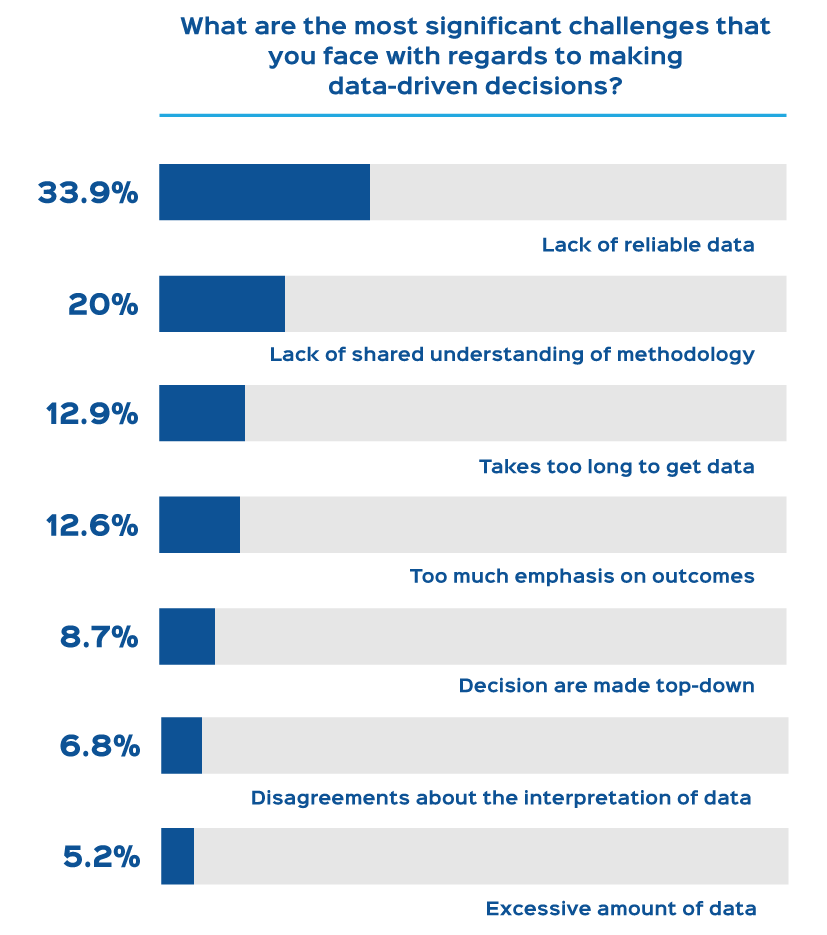
43.2% say they make decisions largely based on deadlines. While speed is critically important in the digital age, it’s critical to balance speed with precision. Lean decision-making techniques such as experimentation still take time, but they are much less costly than the alternative: wasting even more time on a project that doesn’t go anywhere.
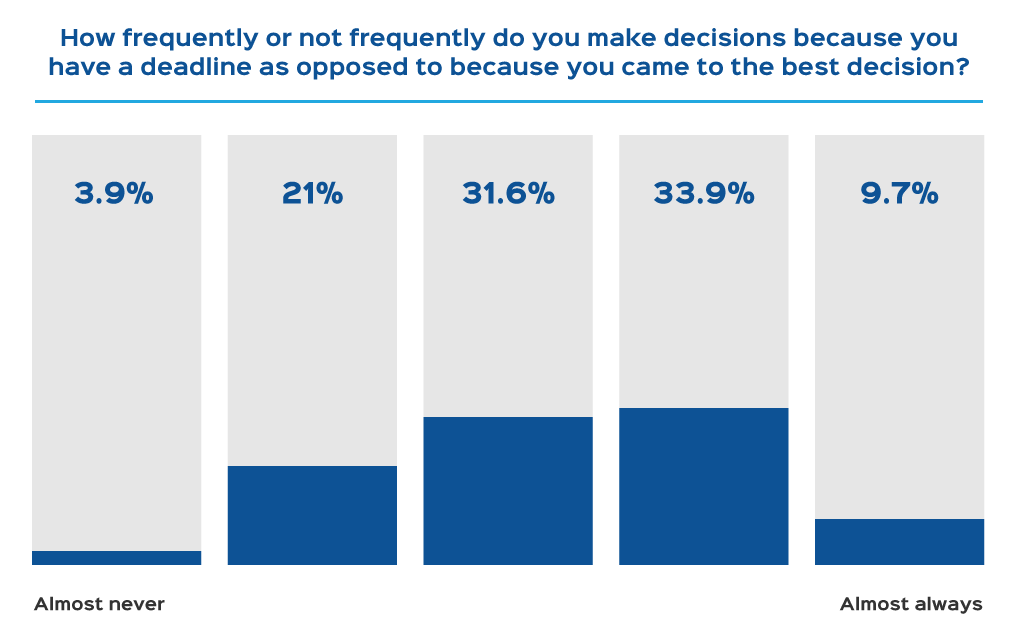
7. Making Change
In today’s fast-paced world, it’s rare for decision-makers to have complete certainty in their decisions. 86.8% report that their work environment is in constant flux or lacking certainty. Compared to people at small companies, people at large companies were more likely to describe their work environment as “Stable.” However, they were about equally as likely to describe it as “chaotic.”
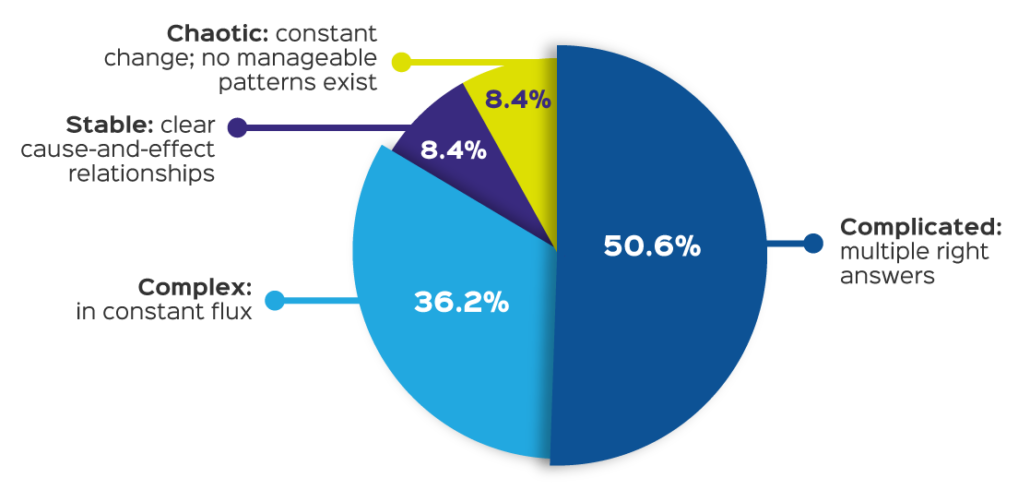
People are generally confident in their decisions: 52.3% are quite certain, and an additional 38.6% are somewhat certain.
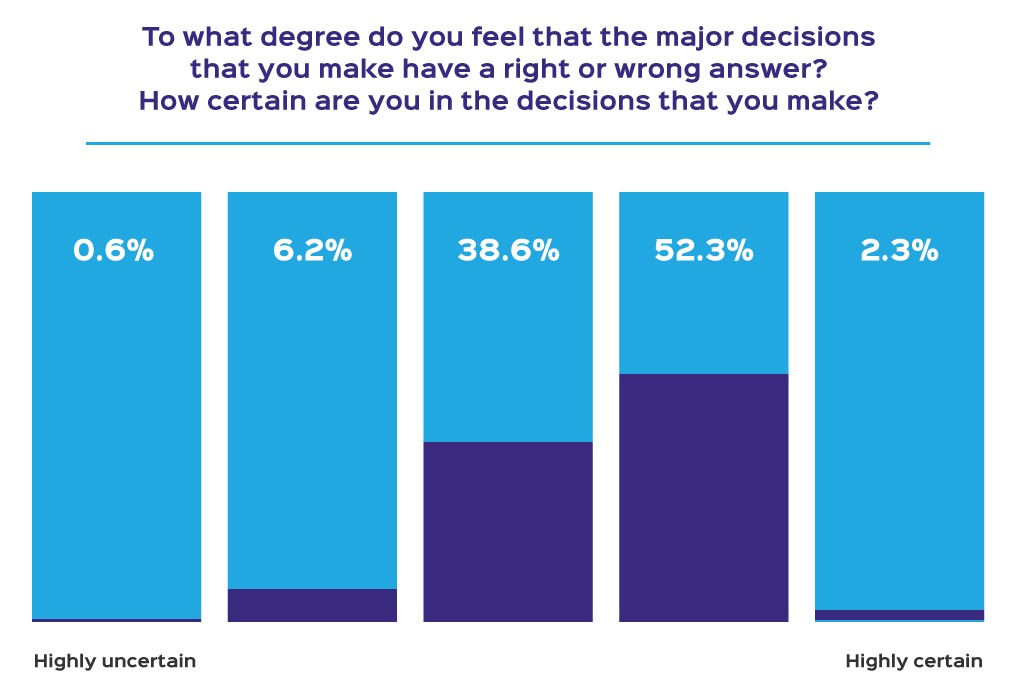
Within the past twelve months, decision-makers have incorporated more experimentation and diverse perspectives.
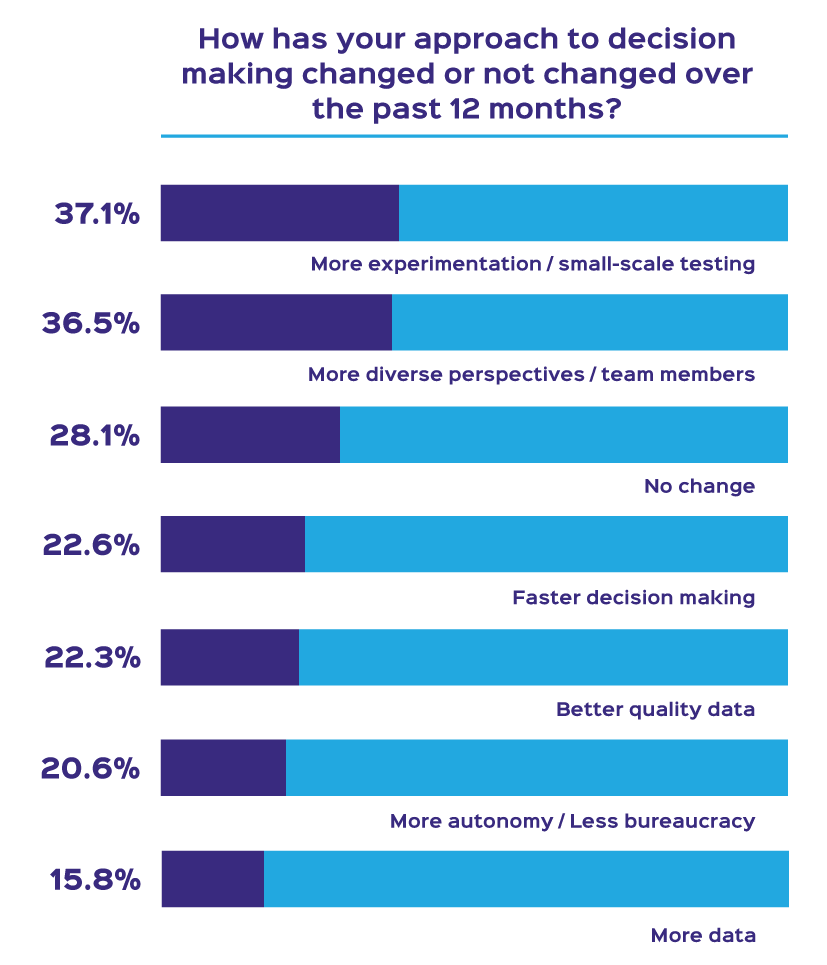
One respondent describes how their experience with a past project that didn’t meet expectations motivated their team to start experimenting:
In the past we made changes on our product based on assumptions and without data. Even after releasing it, we didn’t measure the impact. We changed this way of doing things because we didn’t generate impact. We moved to doing small tests and measuring the KPIs that were supposed to be affected. Working this way has let us increase our release frequency and improve our decision making process. Now every action has an impact and this lets us see if it’s worth it one path or another.
Decision-makers want their teams to have more autonomy and less hierarchy so that those closest to the problem are empowered to make decisions. In addition, even though respondents say they have incorporated experimentation into their decision-making process, they want to do even more.
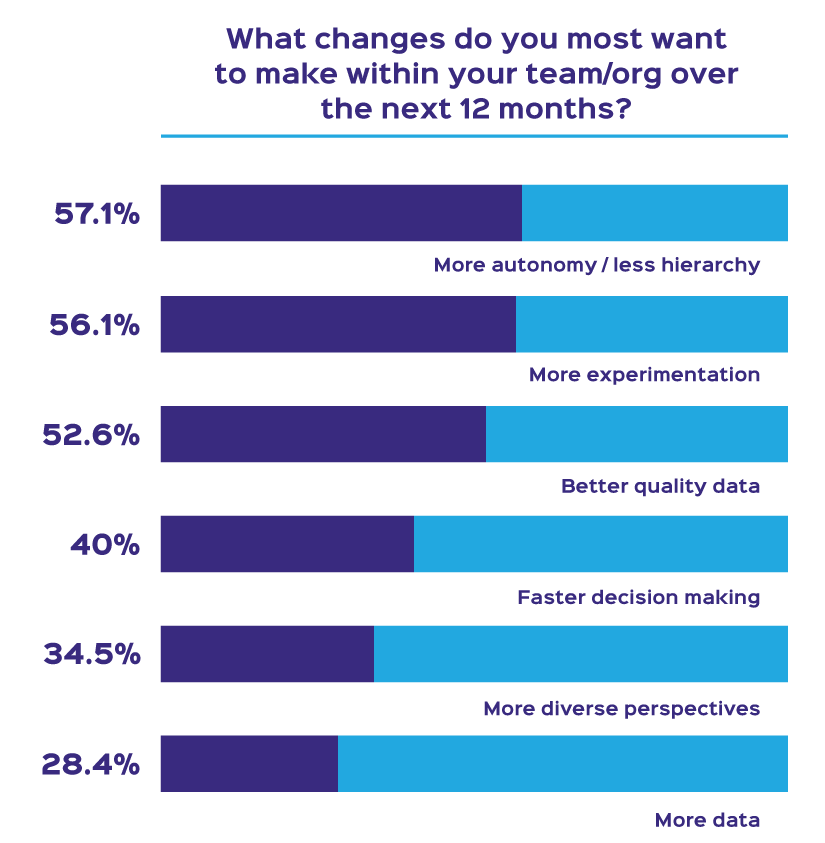
Improving company culture and recruiting innovative talent is the most significant motivator for change. Changing market conditions and customer needs are also major factors.
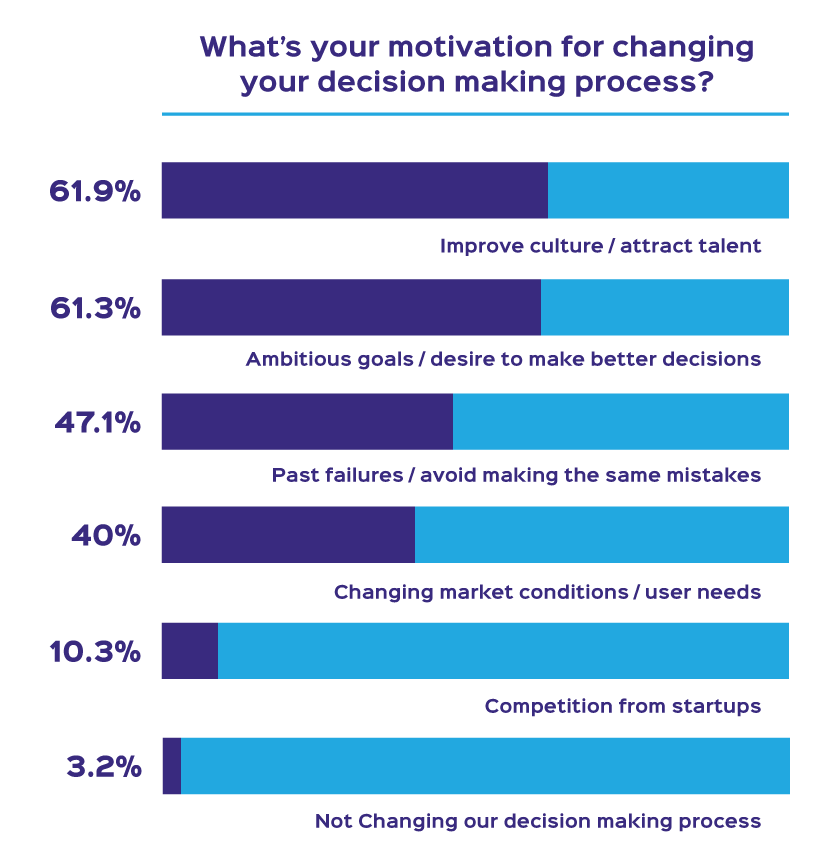
Respondents said that more or better data, better techniques, and a team that’s more open to new ideas would most support their ability to make better decisions.
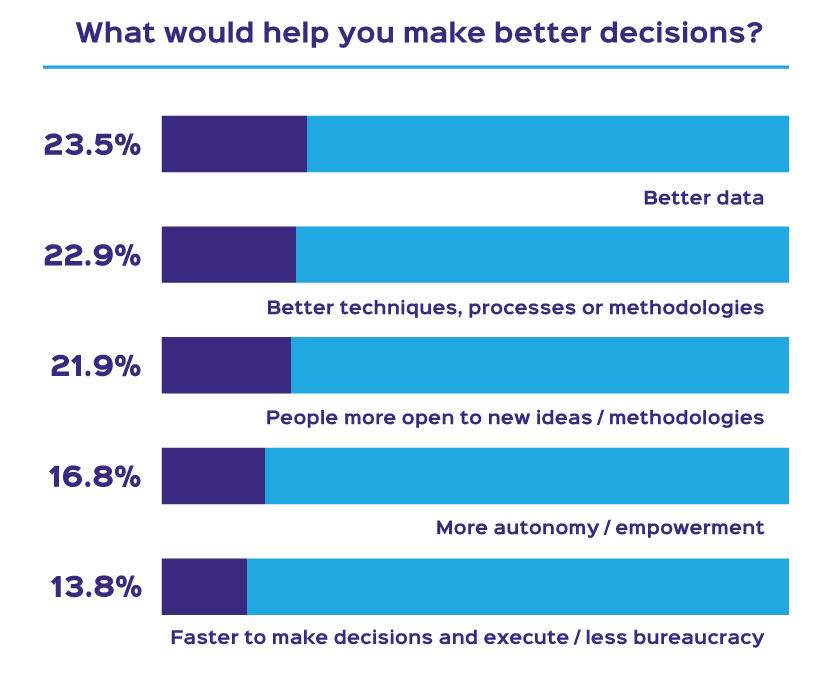
This survey and report were produced by Alphahq.com.


Leave a Reply